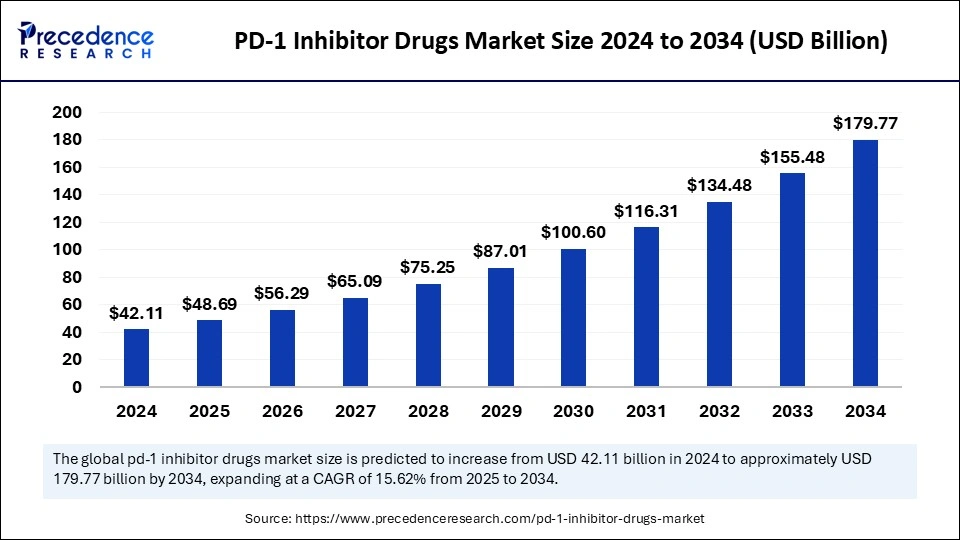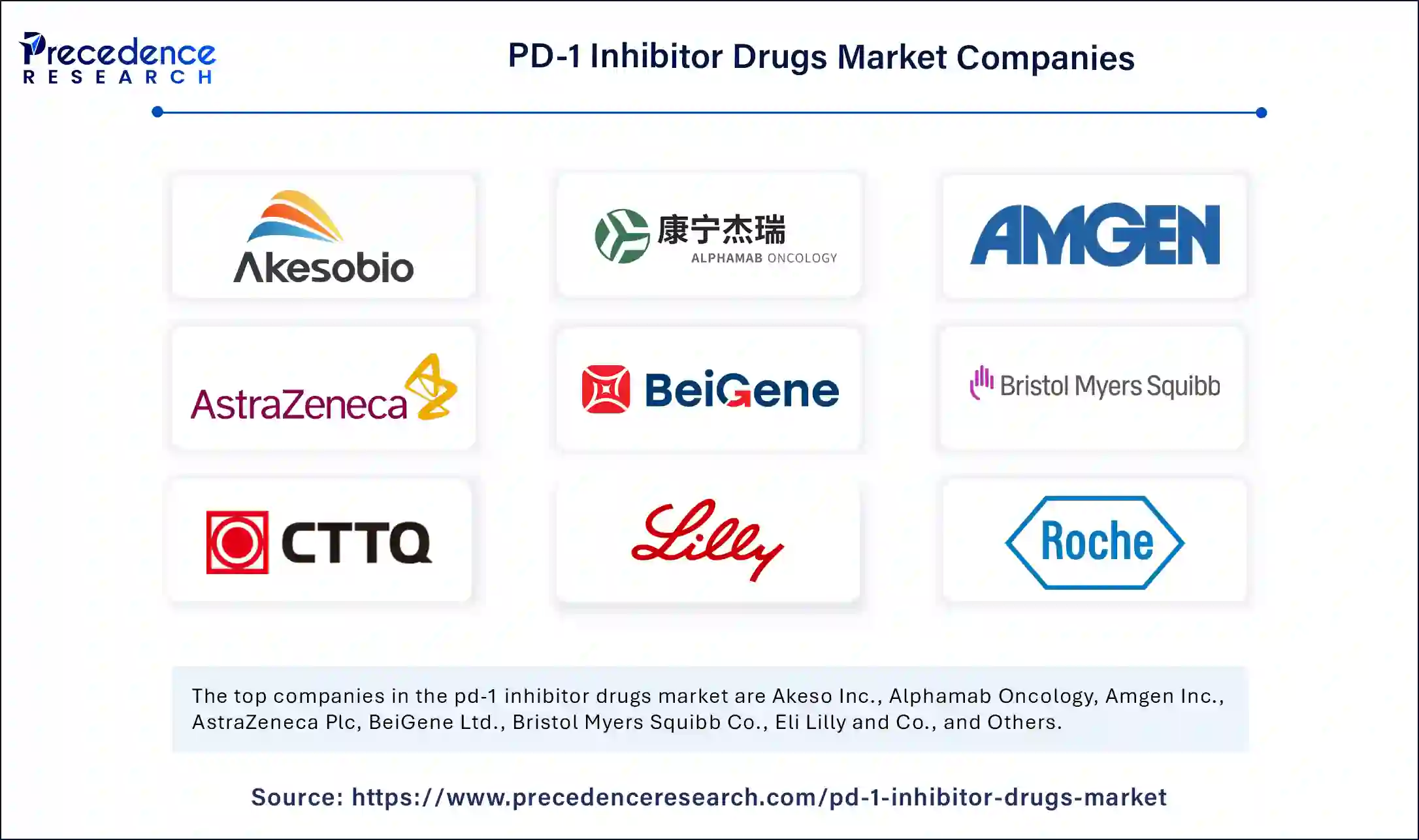PD-1 Inhibitor Drugs Market Size to Surge USD 179.77 Billion by 2034
PD-1 Inhibitor Drugs Market Size and Forecast 2025 to 2034
The global PD-1 inhibitor drugs market size was accounted at USD 42.11 billion in 2024 and is projected to surge around USD 179.77 billion by 2034, growing at a CAGR of 15.62%. The market is driven by rising cancer incidence, expanding regulatory approvals, advanced combination therapeutic approaches, and improved accessibility to innovative immunotherapy.

Get Sample Copy of Report@ https://www.precedenceresearch.com/sample/5718
PD-1 Inhibitor Drugs Market Key Points
- In 2024, North America led the PD-1 inhibitor drugs market in terms of revenue.
- Asia Pacific is expected to witness the highest growth rate during the forecast period.
- The pembrolizumab segment had the highest market share by drug type in 2024.
- The nivolumab segment is projected to grow at a notable pace in the coming years.
- Non-small cell lung cancer remained the most significant indication segment in 2024.
- The melanoma segment is likely to see substantial growth over the study period.
- The hospital pharmacies segment dominated the market based on distribution channels in 2024.
- Online pharmacies are anticipated to expand rapidly in the forecast years.
AI Impact on PD-1 Inhibitor Drugs Market
1. Accelerated Drug Discovery and Development
AI significantly reduces the time required for drug discovery by analyzing vast datasets to identify potential PD-1 inhibitor candidates. Machine learning algorithms predict molecular interactions, optimize compound structures, and enhance drug efficacy, leading to faster and more cost-effective development.
2. Enhanced Clinical Trial Efficiency
AI-powered analytics streamline clinical trial processes by identifying ideal patient groups based on genetic markers and medical history. Predictive modeling helps in assessing drug responses, minimizing trial failures, and accelerating the approval of PD-1 inhibitors.
3. Personalized Cancer Treatment
AI enables precision medicine by analyzing genomic and clinical data to customize PD-1 inhibitor treatments for individual patients. AI-driven insights help oncologists predict treatment responses, adjust dosages, and identify potential combination therapies for improved effectiveness.
4. Optimized Drug Manufacturing and Supply Chain
AI enhances manufacturing efficiency by automating production processes, reducing errors, and ensuring quality control. Additionally, AI-driven supply chain management optimizes inventory, forecasts demand, and minimizes drug shortages or overproduction.
5. Market Intelligence and Competitive Analysis
AI-driven data analytics provide pharmaceutical companies with valuable market insights, helping them understand patient needs, pricing trends, and competitor strategies. AI-powered sentiment analysis also helps in optimizing marketing efforts and increasing PD-1 inhibitor adoption among healthcare providers.
Also Read: Computational Biology Market
Uses of PD-1 Inhibitor Drugs
-
Treatment of Non-Small Cell Lung Cancer (NSCLC)
- PD-1 inhibitors like pembrolizumab and nivolumab are widely used in treating NSCLC by enhancing the immune system’s ability to target and destroy cancer cells.
-
Management of Melanoma
- These drugs help treat advanced melanoma by blocking the PD-1 pathway, allowing immune cells to attack melanoma tumors more effectively.
-
Therapy for Head and Neck Cancers
- PD-1 inhibitors are approved for treating recurrent or metastatic head and neck squamous cell carcinoma, improving survival rates and reducing tumor progression.
-
Treatment of Hodgkin Lymphoma
- PD-1 inhibitors are effective in treating relapsed or refractory classical Hodgkin lymphoma by boosting immune response against lymphoma cells.
-
Bladder Cancer Therapy
- Patients with advanced or metastatic urothelial carcinoma benefit from PD-1 inhibitors when chemotherapy fails, offering an alternative treatment option.
-
Colorectal Cancer with MSI-H or dMMR
- PD-1 inhibitors are used in treating metastatic colorectal cancer in patients with high microsatellite instability (MSI-H) or mismatch repair deficiency (dMMR).
-
Renal Cell Carcinoma (Kidney Cancer)
- PD-1 inhibitors help slow the progression of advanced kidney cancer, often used alone or in combination with other targeted therapies.
-
Triple-Negative Breast Cancer (TNBC)
- Certain PD-1 inhibitors are approved for treating advanced or metastatic TNBC in combination with chemotherapy, enhancing immune response against tumor cells.
-
Gastric and Esophageal Cancers
- PD-1 inhibitors are used to treat advanced gastric and esophageal cancers, particularly in cases where standard treatments are ineffective.
-
Hepatocellular Carcinoma (Liver Cancer)
- These drugs provide an alternative treatment for patients with liver cancer who do not respond well to traditional therapies, improving survival rates.
Market Scope
| Report Coverage | Details |
| Market Size by 2034 | USD 179.77 Billion |
| Market Size in 2025 | USD 48.69 Billion |
| Market Size in 2024 | USD 42.11 Billion |
| Market Growth Rate from 2025 to 2034 | CAGR of 15.62% |
| Dominated Region | North America |
| Fastest Growing Market | Asia Pacific |
| Base Year | 2024 |
| Forecast Period | 2025 to 2034 |
| Segments Covered | Drug Type, Indication, Distribution Channel, and Regions |
| Regions Covered | North America, Europe, Asia-Pacific, Latin America and Middle East & Africa |
Market Dynamics
Market Drivers
One of the key drivers of the PD-1 inhibitor drugs market is the growing incidence of cancer, particularly lung cancer, melanoma, and lymphoma. Increasing investments in immunotherapy research and pharmaceutical advancements are also fueling market expansion. Additionally, regulatory approvals and the availability of government funding for cancer treatment are further accelerating the market’s growth.
Market Opportunities
There are several opportunities in the PD-1 inhibitor drugs market, including the development of combination therapies that improve treatment efficacy. The rise of personalized medicine, where therapies are tailored to individual patient needs, presents a lucrative opportunity for market players. Expanding healthcare infrastructure in emerging markets also provides a significant growth avenue for these drugs.
Market Challenges
Despite its growth, the market faces challenges such as the high cost of PD-1 inhibitors, which limits access for many patients. Side effects and the development of resistance in some cancer types also pose hurdles. Moreover, strict regulatory requirements and prolonged approval processes can delay the introduction of new drugs in the market.
Regional Analysis
North America leads the market due to strong healthcare infrastructure, high adoption rates of immunotherapy, and significant research investments. Asia Pacific is expected to experience the fastest growth due to increasing cancer cases, rising healthcare expenditure, and growing awareness of immunotherapy treatments. Meanwhile, Europe is witnessing steady expansion, driven by advancements in oncology research and government support for cancer treatment.
PD-1 inhibitor drugs market Market Companies

- Akeso Inc.
- Alphamab Oncology
- Amgen Inc.
- AstraZeneca Plc
- BeiGene Ltd.
- Bristol Myers Squibb Co.
- Chia Tai Tianqing Pharmaceutical Group Co. Ltd.
- Eli Lilly and Co.
- F. Hoffmann La Roche Ltd.
- Gilead Sciences Inc.
- GlaxoSmithKline Plc
- Innovent Biologics Inc.
- Jiangsu Hengrui Pharmaceuticals Co. Ltd.
- Merck and Co. Inc.
Recent Developments
- In November 2024, Dr. Reddy’s Laboratories initiated Zytorvi (Toripalimab) sales as a next-generation immune therapy for patients suffering from head and neck cancer and nasopharyngeal carcinoma. This next-gen PD-1 inhibitor makes India the world’s third nation to access the treatment, which presents a better medical alternative than standard chemotherapy.
- In September 2024, the FDA granted approval to Roche for Tecentriq Hybreza (atezolizumab and hyaluronidase-tqjs) as a first PD-L1 inhibitor with subcutaneous administration access. Approval permits Tecentriq Hybreza for treating every adult disease indication of intravenous Tecentriq among selected lung cancer and skin cancer types with liver and soft tissue types.
Segments Covered in the Report
By Drug Type
- Pembrolizumab
- Nivolumab
- Cemiplimab
- Dostarlimab
- Others
By Indication
- Melanoma
- Hodgkin Lymphoma
- Non-Small Cell Lung Cancer
- Kidney Cancer
- Head And Neck Cancers
- Stomach Cancer
- Others
By Distribution Channel
- Hospital Pharmacies
- Retail Pharmacies
- Online Pharmacies
By Geography
- North America
- Europe
- Asia Pacific
- Latin America
- Middle East and Africa
Ready for more? Dive into the full experience on our website@ https://www.precedenceresearch.com/
